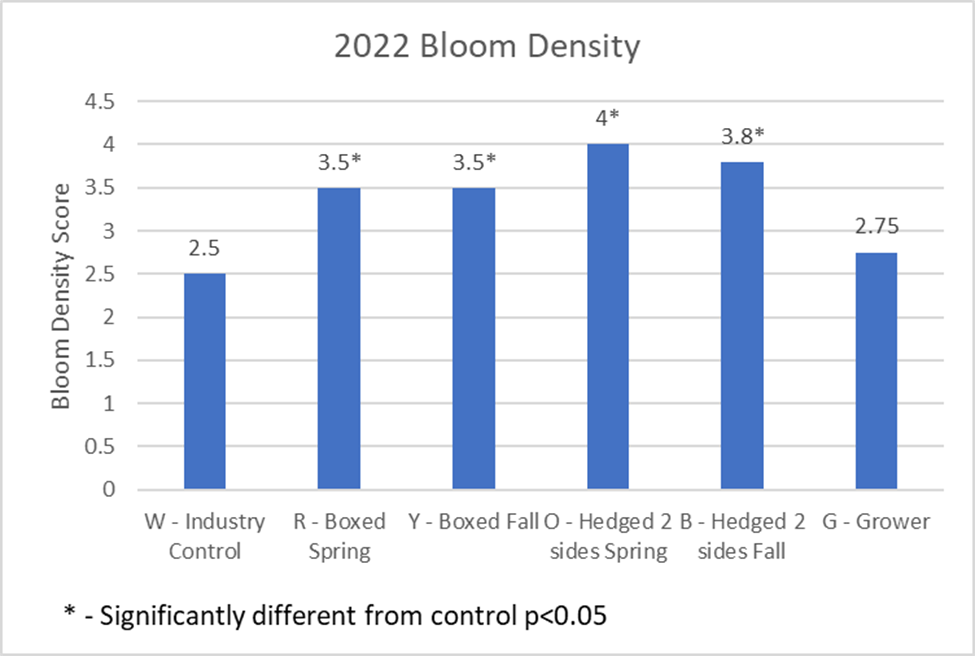Becky Wheeler-Dykes, Orchard Researcher, CSU Chico
Dr. Rich Rosecrance, Professor, College of Agriculture, CSU Chico
Luke Milliron, UCCE Farm Advisor Butte, Tehama and Glenn Counties
Franz Niederholzer, UCCE Farm Advisor, Colusa and Sutter/Yuba Counties
2022 was an interesting year at the mechanical pruning trial site in Red Bluff. The trial, funded by the California Prune Board and led by Dr. Rich Rosecrance at Chico State, was initiated in 2019 and aims to identify lower cost pruning alternatives for growers without compromising yield or fruit quality. The study site is an orchard planted in 2011 at a spacing of 15’ x 18’ on Myrobalan seedling rootstock and irrigated with buried drip. The study treatments are:
- Fall: Grower standard — ladders and loppers pruning, no topping (i.e. ‘control’).
- Spring: Topping and hedging both ways — cutting 5 sides of the canopy, with the tree row and across the tree row, plus topping (i.e. ‘boxed’).
- Fall: Topping and hedging both ways — cutting 5 sides of the canopy, with the tree row and across the tree row, plus topping (i.e. ‘boxed’).
- Spring: Hedging both sides of the tree row, no cross hedging — cutting 2 sides of the canopy, no topping (i.e. ‘hedged’).
- Fall: Hedging both sides of the tree row, no cross hedging — cutting 2 sides of the canopy, no topping (i.e. ‘hedged’).
Additionally, data was collected in the grower’s field (‘grower control’). These trees are pruned using a hybrid of mechanical hedging with occasional hand-pruning to maintain the tree structure. Decisions on when or whether to hand-prune are made on a year-by-year basis as needed.
Several measurements are collected annually to assess the effects of the pruning treatments. Highlights of 2022 include:
- Canopy volume was measured in May 2022. Trees boxed in spring were significantly smaller than the hand-pruned control. Trees boxed in fall or hedged in fall or spring did not differ significantly from the control. It was observed that there is less regrowth of large wood, so cuts made in hedging were predominantly on small shoots. This is desirable, as it maintains a balance in vegetative and reproductive buds. Unsurprisingly, the light interception of the various treatments followed the same pattern.
- A survey of canker development on mechanical hedging wounds was conducted in October 2022. While there was not a significant difference between treatments in how many wounds developed cankers, the hand-pruned controls did have a lower percentage of cankered wounds than the hedging treatments. Of the cankers that were observed, there was no difference in how large or severe the canker development was between any of the treatments, including the controls. Intensive studies are planned for 2023 to determine how disease develops in hedging wounds and gain targeted knowledge of the effects of disease mitigation practices in different hedging treatments.
- In 2021, a difference in severity of sunburn damage after extreme heat events was observed. This pattern continued in 2022; the boxed treatments both had less blue prune drop due to sunburn damage than the control. Conversely, the hedged treatments had more blue prune drop than the control. Pressure chamber data during extreme heat indicated no difference in stress. It may be possible that bowing branches in the hedged trees, exposing fruit to intense light in the late summer, may have contribute to these differences. We will continue to assess sunburn damage in 2023.
- 2021 treatment yields ranged between 3.0 and 4.1 dry ton marketable (A+B screens) yield per acre and no significant differences were found among the treatments in 2022 nor in cumulative yields (Table 1). With such large yields even after thinning, large fruit (A + B screens) comprised between 68% and 92% of the four-pound sample from all the treatments (Table 2). The Fall boxed treatment did have significantly lower percentage of marketable (A+B screen) fruit than all other treatments.
- 2021 yields varied (Table 1), with particularly heavy crop loads in the hedged treatments. This led to concerns that the hedging treatments may induce a cycle of alternate bearing. Because of this, bloom density was rated to establish the effects of the 2021 yield on 2022 return bloom. Surprisingly, all boxed and hedged treatments had significantly higher bloom density than either the hand-pruned control or the grower control (Figure 1). This seems to have correlated well with the 2022 yields. We will continue to assess return bloom in 2023.

Figure 1. 2022 bloom density scores. Plots were rated visually on a scale of 1-5, where 1 = very few blooms and 5 = extremely profuse blooms.




Leave a Reply